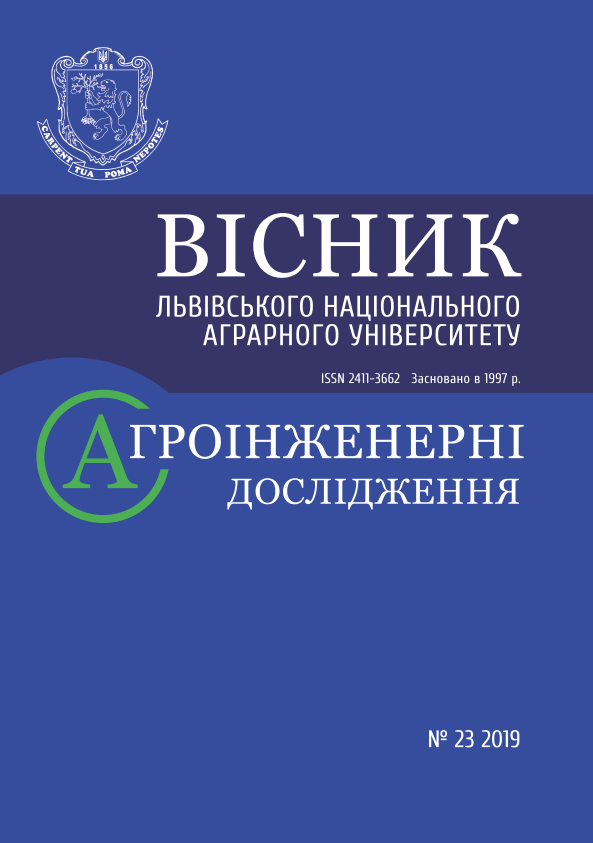TRIBO-CORROSION RESISTANCE OF CARBON STEELS WITH ARC-SPRAYED COATINGS USING POWDER ELECTRODES 60Х15Р2ГС AND 75X19Р3С2
DOI:
https://doi.org/10.31734/agroengineering2019.23.117Keywords:
electro arc coatings, corrosion, tribocorrosion, chlorides, hydrogen sulfide, ammoniaAbstract
The article is devoted to the study of electro arc coatings, deposited on steel from powder wire electrodes 60Х15Р2ГС and 75X19Р3С2. The coatings have a heterogeneous structure, which consists of a martensitic matrix, strengthened by finely dispersed inclusions of FeCrB and FeCr2B borides. Hardness of the coatings with PW 60Х15Р2ГС constitutes 560 HV, whereas PW 75X19P3C2 – 545 HV. The corrosion and tribocorrosion characteristics of coatings were studied in the following solutions: 3 % NaCl; 3 % NaCl + 0,025 % (NH4OH) and 3 % + Н2S(sat.). In the solutions, the corrosion currents of coatings decrease, when pH changes from 4 to 9. It is explained by the stability of the coating components in neutral and alkaline environments. In the hydrogen sulfide medium, sulfur-contained films are formed on the surface, which act as a solid lubricant during friction, and reduce the adhesive component of the contact interaction. It supports reducing of the friction coefficients and material wear. In the ammonia environment, hard nitrogen-containing films are formed in the contact area. It increases the coefficient of friction. In 3 % NaCl, the corrosion resistance of coatings is the lowest one. In the environment, chlorine ions accelerate the corrosion of coatings, and the combined effect of corrosion and mechanical factors during friction leads to a decrease in wear resistance.
Sulfide- and nitrogen-containing secondary structures are formed on the surface of the gas-thermal coating in corrosive environments. These films can significantly reduce the negative impact of both corrosion and tribological factors. It is shown that the coating, which is obtained by electric arc spraying from PW 75X19Р3С2, has better corrosion and tribocorrosion resistance. Its corrosion resistance, in particular, is provided by a high content of chromium, which rieaches 19%. The presence of carbide and boride phases in the electro arc coatings provides increased hardness and wear resistance of coating.
References
Pokhmurskyi, V., Student, M., Pokhmurska H., Ryabcev, I., Gvozdeckii, V., & Stupnytskyy, V. (2013). Gazoabrazinnaya iznosostojkost pri povyshennyh temperaturah pokrytiy, poluchennyh duhovoj metallizaciej. Avtomaticheskaja svarka, 6, 16–23.
Pokhmurskyi, V., Student, M., Stupnytskyy, V., Chervinska, N., & Kondyr A. (2012). Zasady stvorennia koroziinostikykh elektroduhovykh pokryttiv z poroshkovykh drotiv. Fizyko-himichna mehanika materialiv, 9(2), 600–606.
Khoma, M. S., Pereplotchikov, E. F., Vasyliv, Ch. B., Vynar, V. A., Ryabtsev, I. A., Ratska, N. B., & Ivashkiv, V. R. (2019). Corrosion and tribocorrosion properties of plasma coatings on the base of iron, nickel and chromium in environments, which contain hydrogen sulfide, chloride and ammiac. Naukovi notatky, 66, 356–361.
Pokhmurska, H. V., Student, М. М., & Pokhmurskyi, V. І. (2017). Gazotermichni pokryttia: Navch. posib. Lviv: Prostir-М.
Pokhmurskyi, V., Student, M., Stupnytskyy, V., & Chervinska, N. (2013). Struktura, mehanichny ta elektrokhimichni kharakterystyky koroziinostiikykh elektroduhovykh pokrytttiv z poroshkovykh drotiv. Naukovi notatky, 2(41),127–132.
Khoma, M. S., Ivashkiv, V. R., & Galaichak, S. A. (2019). Vplyv struktury stalei na koroziiu, navodniuvannia ta koroziine roztriskuvannia u sirkovodnevykh seredovyshchakh. Fizyko-khimichna mekhanika materialiv, 2, 121–125.
Tian, J.-J., Yao, S.-W., Luo, X.-T., Li, C.-X., & Li, Ch.-J. (2016). An effective approach for creating metallurgical self-bonding in plasma-spraying of NiCr-Mo coating by designing shell-core-structured powders. Acta Materialia, 110, 19–30.
Pokhmurskyi, V., Student, M., Gvozdeckii V., Stupnytskyy, T., Student, O., Wielage, B., & Pokhmurska, H. (2013). Arc-sprayed iron-based coatings for erosion-corrosion protection of boiler tubes at elevated temperatures. Journal of Thermal Spray Technology, 22 (5), 808–819.
Bobzin, K., Zhao, L., Öte, M., & Königstein, T., 2017. Novel Fe-based wear and corrosion resistant coatings by three-cathode plasma technology. Surface and Coatings Technology. 318, 288–292.
Khoma, M. S., Ivashkiv, V. R., Chuchman, M. R., Vasyliv, Ch. B., Ratska, N. B., & Datsko, B. M. (2018). Corrosion cracking of ferrite-pearlitic steels of different structure in the hydrogen sulfide environment under static load. Procedia Structural Integrity, 13, 2184–2189.
Student M., Veselivska, H., Gvozdecki, V., Golovchuk, M., Dzyubyk, L., & Sirak, Ya. (2008). Corrosion-mechanical resistance of arc-sprayed coatings made from cored powders. Ukrainian Journal of Mechanical engineering and materials science, 2008, 4(1), 12–20.
Dilthey, U., & Kabatnik, L. (1998). Zentral Pulverzufuhr beim Plasmauftragschweien. Schweien und Schneiden, 12, 766–771.
Hejwowski, T. (2006). Sliding wear resistance of Fe-, Ni- and Co-based alloys for plasma deposition. Vacuum, 80 (11-12), 1326–1330.
Wielage, B., Pokhmurska, H. Student, M., Gvozdeckii, V., Stupnytskyy, T., Pokhmurski, V., & Wielage, B. (2013). Iron-based coatings arc-sprayed with cored wires for applications at elevated temperatures. Surface and coating technology. 220, 27–35.
Klimpel, A., Dobrzański, L. A., Lisiecki, A., & Janicki, D. (2006). The study of the technology of laser and plasma surfacing of engine valves face made of X40CrSiMo10-2 steel using cobalt-based powders. Journal of Materials Processing Technology, 175 (1–3), 251–256.
Li, B., Jia, J., Han, M., Gao, Y., & Li, C. (2017). Microstructure, mechanical and tribological properties of plasma-sprayed NiCrAlY-Mo-Ag coatings from conventional and nanostructured powders. Surface and Coatings Technology, 324, 552–559.
Pokhmurskyi, V., Student, M., Chervinska, N., & Stupnytskyy, V. (2013). Electrochemical properties of arc sprayed coatings from cored wires on the basis of cheap ferroalloys. Оchrona przed korozja, 11, 516–518.
Stupnytskyi, T. R., Student, M. M., Pokhmurska, H. V., & Hvozdetskyі, V. M. (2016). Optimization of the Chromium Content of Powder Wires of the Fe–Cr–C and Fe–Cr–B Systems According to the Corrosion Resistance of Electric-Arc Coatings. Materials Science, 52, 165–172.
Voitovych, A., Pokhmurska, H., Student, M., & Student, O. (2016). Microstructure and Abrasive-Wear Resistance of the Vibration-Deposited Metal of Core Wires of the Basic Fe–Cr–B System. Materials Science, 52, 365–370.
Bolelli, G., Milanti, A., Lusvarghi, L., Trombi, L., & Vuoristo, P. (2016). Wear and impact behaviour of High Velocity Air-Fuel sprayed Fe–Cr–Ni–B–C alloy coatings. Tribology International, 95, 372–390.


